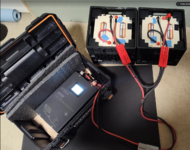Of note, the battery is charged at the exact same voltage (I don't recall the voltage) no matter if the charger is running of 120v or 240v. Battery resistance doesn't figure into this conversation because the charger charges the battery with the exact same voltage no matter which voltage the charger runs off of. Similar to how a usb charger pushes 5v to a device battery (phone, tablet) no matter if the adapter (with built in converter) is plugged into a 120v or 240v outlet.
Otherwise, the thought process behind using a converter to work around the current Varg 10amp charging limitation is a good one. But a big part of the decision will be based on max charge rate on 120v, which may change in the future. Originally Starg said 15amps (on both 120v and 240v), but it seems limited to 10 amps on both currently. If 120v is limited to 10amps, then converting will let you charge faster. But if 120v allows the full 15amps (now or in the future with an update), then 120v x 15amps is 1,800watts.
There is also the inefficiency of the Varg charger to consider. I'm not clear if, when the Varg display says 240v 10amp charge rate, if that is what the bike is receiving from the charger or if that is what the charger is drawing from it's source (and so the bike is receiving the 5% to 10% less due to the losses in the charger). But I'm assuming the display is showing the amount of power going to the battery. That means the charge is drawing a % more than that due to charger losses. I bring that up because if your generator has a max output of 1700watts sustained, you can't set the bike to that exact 1700watt rate because the bike charger, and your converter, will have losses. You'd mentioned 7.7amps if converted to 240v. You won't be able to set the bike to 7.7amps or your generator will be overdrawn. Even if the converter losses are only 5% (I think it will be more), that means your sustained output is reduced by that 5% and then another 5% on top of that for Varg charger losses.
We'll use watts to keep it simple. Working backwards from your generators, sustained 1,700 watts max, 5% converter loss brings that down to 1,615 watts. Then another 5% loss from the Varg charger brings that down to 1,534 watts sustained that can flow to the battery without overloading your generator. 1,534watts / 240v = 6.4amps so 6.4amps would be the max you can set the battery charge rate to not trip your generators safety. That calculation will depend on the exact losses of the converter and the charger, but easy enough to plug in those numbers when you find them out.
By comparison, if you don't use a converter, you'll have only the 5% loss from the Varg charger. 1700w turns to 1,615watts. So the Varg charger would have to allow 1,615w / 120v = 13.45amps charging on 120v to break even with the max your generator can produce if using a 240v converter. If the Varg does allow 13.45amp charge rate on 120v (today or with future update), then charging on 120v would charge as fast as with your converter to 240v. If the Varg only allows a max of 10amp charge rate on 120v (today and in the future), then it is capping the current that is getting to the battery 1,200watts. For comparison, the 240v converter, as calculated in the previous paragraph, would be able to push 1,534watts to the battery. You'll charge 1.28x faster with your 240v converter. Probably worth it. But if Varg charger will allow a 13.45 amp charge rate on 120v, now or in the future, then no reason to mess with a converter.
All that being said, if you are going to spend money on a converter and only get 22% faster charge rate, it seems a better use of money is to sell your current generator and take the money from that and the money that you would have spent on a converter, and put it towards a generator capable of 240v and output of 4,000 or more watts. Then you can charge at 240v x 10amp = 2,400 watts now, which is 2 times faster than 1,200 watts and 1.56 times faster than even your current generator converted to 240v. And, if Varg does an update to allow 240v x 15amp = 3,600watt charge rate, you'll already have the generator and will be faster still. Except for a bit more expense and a bit more weight, there is only upside to the larger generator. It will charge your Varg as fast and possible, will give you a lot more power for household and remote uses, have both 240v and 120v plugs, etc.

